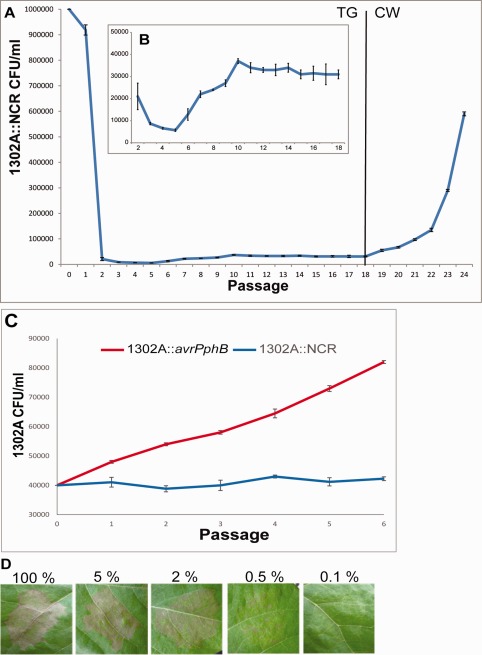Figure 4.

Population dynamics of Pseudomonas syringae pv. phaseolicola strain 1302A::NCR during exposure to host plants.
A. Initially leaves of bean cultivar Tendergreen (TG) were inoculated at an inoculum density of OD600 0.1 with 2% Pph 1302A::NCR and 98% RJ3. After 7 days, the cells were harvested, diluted to the starting inoculum density, and reinoculated into a new leaf. This process was repeated 24 times, weeks 1–18 in TG followed by weeks 19–24 in bean cultivar Canadian Wonder (CW). (B) Zoomed in view between weeks 2 and 18. (C) The population of 1302A can increase in planta if avrPphB is inactivated. An avrPphB disruption mutant Pph 1302A::avrPphB and 1302A::NCR was passaged six times through resistant bean cv. TG at an initial inoculum concentration of 0.5% 1302A and 99.5% RJ3 to mimic that found at week 18. Colony‐forming units (CFUs) retaining kanamycin resistance and therefore PPHGI‐1 were counted after each passage. Mean is of three replicates ± SEM. (D) Phenotypes displayed by Pph 1302A::NCR on bean cv. TG at various concentrations of bacteria. Bean cv. TG leaves were inoculated with Pph 1302A::NCR OD600 0.1 concentrations of 100% (8 × 107), 5% (4 × 106), 2% (1.6 × 106), 0.5% (4 × 105) and 0.1% (8 × 104) made up to 8 × 107 cells ml−1 with Pph RJ3. These concentrations represent the levels of Pph 1302A::NCR observed at various time points in (A) and (B). Symptoms were recorded after 24 hours.
